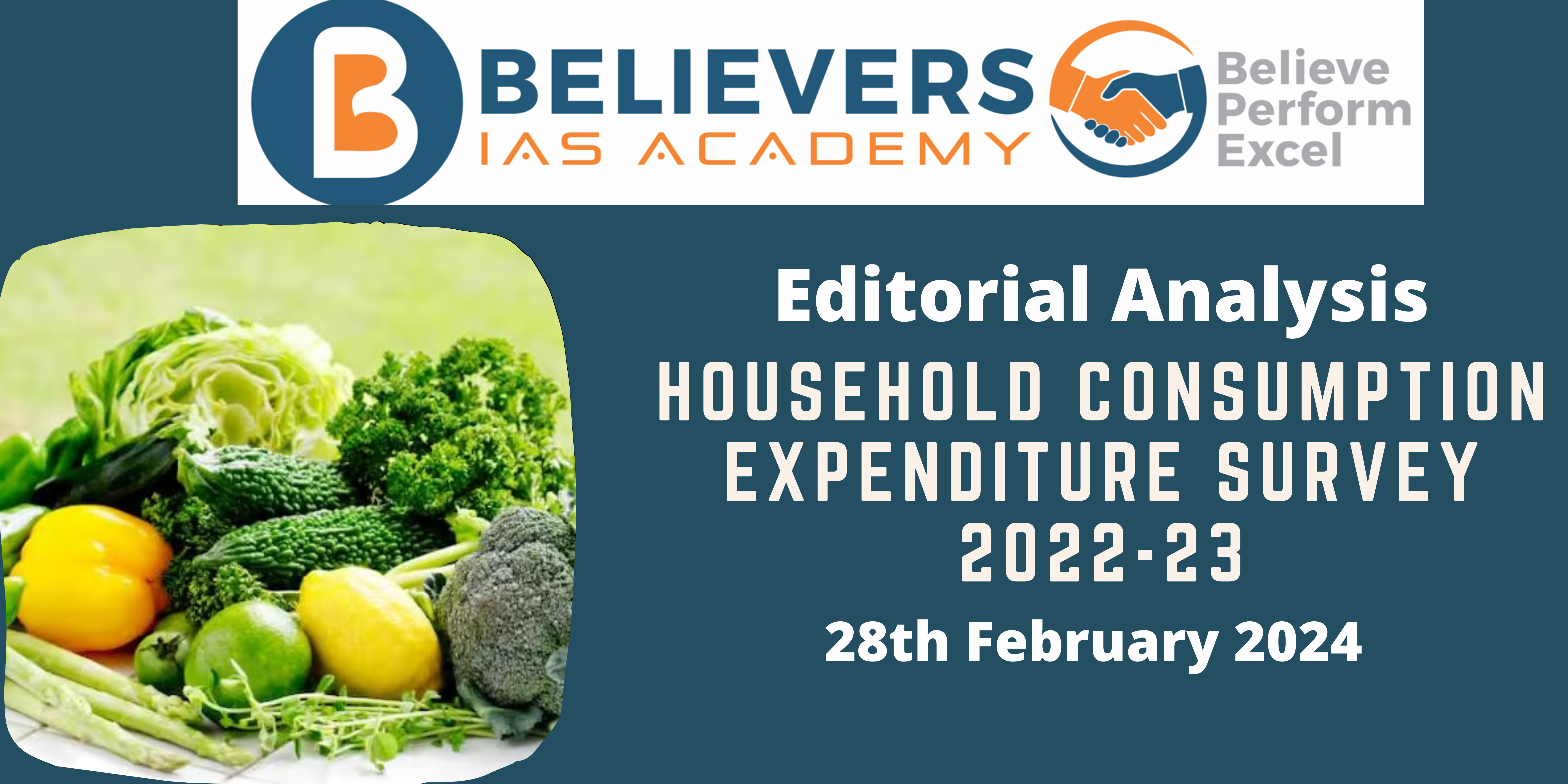Household Consumption Expenditure Survey 2022-23
Context:
The latest Household Consumption Expenditure Survey reveals shifts in consumption patterns.
- Conducted between August 2022 and July 2023, this survey is the first major data release since 2011-12, providing insights into ground realities at the household level.
Relevance:
GS-03 (Economy)
Key Highlights:
- While the survey indicates a rise in average monthly per capita consumer expenditure (MPCE), caution is needed in interpreting the data due to the influence of pent-up demand and inflationary trends.
- Changes in spending patterns, particularly the decline in the proportion of monthly expenditure on food, are noteworthy and may impact inflation calculations.
Dimensions of the Article:
- Key findings: Household Consumption Expenditure Survey 2022-23
- Interpretation Challenges
- Rise in Consumer Expenditure
- Shifts in Spending Patterns
- Need for Caution in Analysis
Key findings: Household Consumption Expenditure Survey 2022-23
- Average Monthly Per Capita Consumption Expenditure (MPCE):
- The latest survey reveals that the average MPCE in urban households increased by 33.5% since 2011-12 to ₹3,510, while rural India saw a 40.42% rise to ₹2,008. Notably, these figures exclude the imputed values of free items obtained through welfare programs like PM Garib Kalyan Ann Yojana (PMGKAY) but include select non-food items like computers, mobile phones, bicycles, and clothing.
- When including the imputed cost of free items, the average monthly consumption expenditure stood at Rs 3,860 in rural areas and Rs 6,521 in urban areas.
- Difference in Average MPCE between Rural and Urban Households:
- The gap in average MPCE between rural and urban households narrowed to 71.2% in 2022-23 from 83.9% in 2011-12, indicating a relatively higher increase in rural consumption spending over the 11-year period.
- Average MPCE of the Bottom 5% of Rural and Urban Populations:
- The bottom 5% of the rural population has an average MPCE of Rs 1,373, while it is Rs 2,001 for the bottom 5% of the urban population. Conversely, the top 5% of both rural and urban populations have significantly higher average MPCE of Rs 10,501 and Rs 20,824, respectively.
- Share of Expenditure on Food:
- In 2022-23, the share of expenditure on food was 46% (Rs 1,750) in rural India and 39% (Rs 2,530) in urban India, indicating a decrease from 2011-12 levels. This shift has implications for consumer price index-based inflation.
- Consumption Expenditure on Non-food Items:
- The rise in the share of spending on conveyance, consumer services, and durable goods drove the consumption expenditure on non-food items in both rural (54%) and urban (61%) India in 2022-23. Conversely, the share of expenditure on cereals, pulses, and vegetables decreased during this period.
- Comparison Among States:
- Sikkim has the highest MPCE among states, with ₹7,731 for rural areas and ₹12,105 for urban areas. In contrast, Chhattisgarh has the lowest MPCE, with ₹2,466 for rural households and ₹4,483 for urban households.
Interpretation Challenges:
- The recent Household Consumption Expenditure Survey offers valuable insights into changing consumption patterns but warrants careful interpretation.
- Conducted amid the aftermath of the pandemic and economic disruptions, the data may reflect the release of pent-up demand rather than sustainable growth in incomes.
Rise in Consumer Expenditure:
- The survey highlights a notable increase in average monthly per capita consumer expenditure (MPCE), signaling potential improvements in household incomes.
- However, it’s essential to consider the modest growth rates over the past decade, which lag behind inflation and GDP growth rates.
Shifts in Spending Patterns:
- One of the striking findings is the decline in the proportion of monthly expenditure allocated to food, particularly in rural households. This shift may have implications for inflation calculations, especially considering the recent spikes in food prices.
Need for Caution in Analysis:
- While the survey provides valuable insights, it’s crucial to exercise caution in interpreting the findings.
- Factors such as pent-up demand and fluctuations in inflation could distort the data. A comprehensive analysis should await the completion of the ongoing survey and the release of updated results.
Way Forward:
- The Household Consumption Expenditure Survey offers a snapshot of evolving consumption patterns and economic trends. However, policymakers and economists must approach the data with caution, considering the influence of external factors such as pent-up demand and inflationary pressures.
- A thorough analysis, based on updated survey results and a deeper understanding of ground realities, will be essential for informed decision-making and policy formulation.




